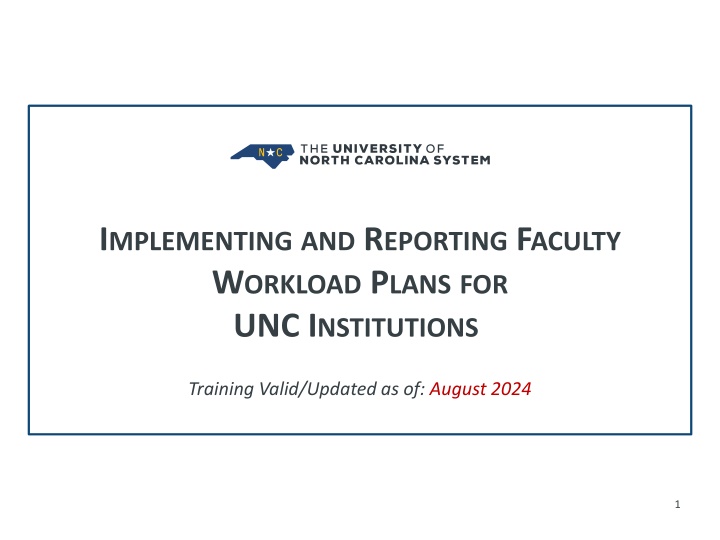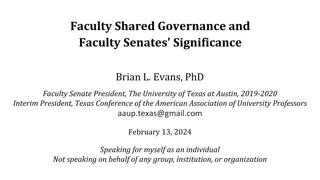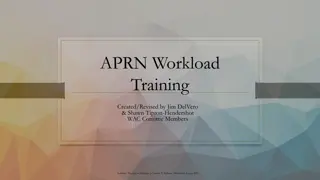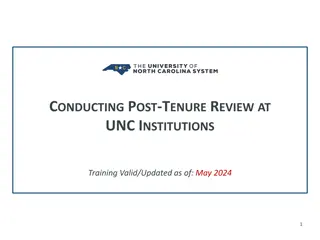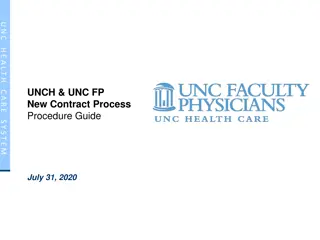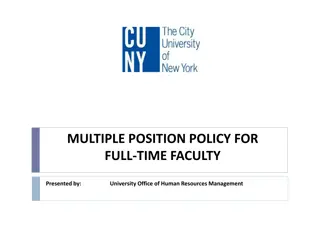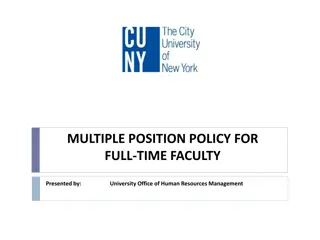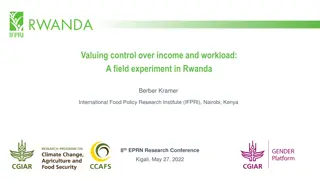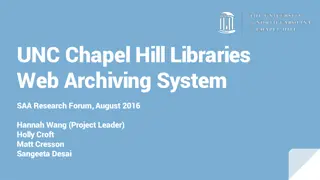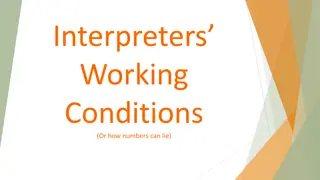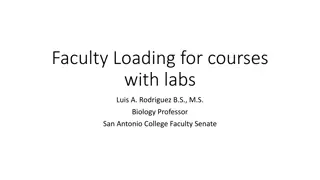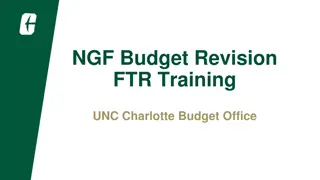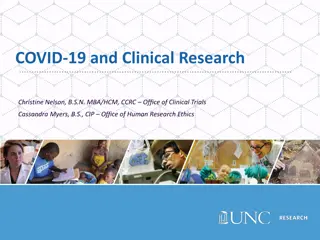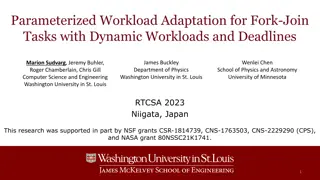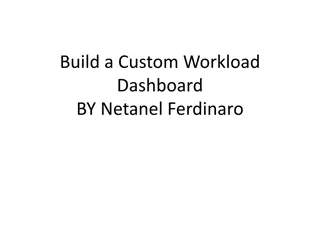UNC Faculty Workload Policy Training Overview
This training focuses on implementing and reporting faculty workload plans for UNC institutions based on Policy 400.3.4 and Regulation 400.3.4[R]. It covers the purpose, definitions, significant dates, best practices, requirements, and institutional reporting related to faculty workload. The objective is to ensure consistent and effective monitoring of faculty workloads with an emphasis on teaching, research/creative activity, and service roles. Participants will gain knowledge to prepare and submit accurate workload plans as per UNC guidelines.
Download Presentation

Please find below an Image/Link to download the presentation.
The content on the website is provided AS IS for your information and personal use only. It may not be sold, licensed, or shared on other websites without obtaining consent from the author.If you encounter any issues during the download, it is possible that the publisher has removed the file from their server.
You are allowed to download the files provided on this website for personal or commercial use, subject to the condition that they are used lawfully. All files are the property of their respective owners.
The content on the website is provided AS IS for your information and personal use only. It may not be sold, licensed, or shared on other websites without obtaining consent from the author.
E N D
Presentation Transcript
IMPLEMENTING AND REPORTING FACULTY WORKLOAD PLANS FOR UNC INSTITUTIONS Training Valid/Updated as of: August 2024 1
OBJECTIVEAND OVERVIEW Training is based upon UNC Policy 400.3.4 , Policy on Faculty Workload and 400.3.4[R], Regulation on Faculty Workload. Per policy, UNC's constituent institutions should deploy and monitor "...faculty workloads in a consistent efficient and effective manner" and that teaching "...should be the first consideration." The policy and training will promote well-informed participation and adherence to consistent planning and tracking of annual workload documents for all faculty to showcase their essential and valued roles across the University in teaching, research/creative activity, and service. Training is required for participants preparing and submitting faculty workload plans, and units reporting and submitting reports on faculty workload plans. 2
TRAINING OVERVIEW 1. Purpose 2. Definitions 3. Faculty Workload Report significant dates 4. Best practices 5. Requirements 6. Institutional reporting 7. Recap 3
PURPOSE The Faculty Workload policy and regulation provide guidance to institutions as they develop and adopt faculty workload policies and faculty workload planning procedures. The policy places reporting requirements on UNC System institutions and the UNC System Office. This training provides further clarification on the information institutions may choose to include and specifies the information institutions must include to satisfy the intent of the policy and regulation. 4
DEFINITIONS Academic unit academic department, professional school, or equivalent constituent unit of an institution. o Example: The College of Business has (xx number) of departments. o The College of Business and each department included in the College are all academic units. Faculty employees appointed to carry out responsibilities such as instruction, research/creative activity, service, clinical care, or extension. Full time equivalent a workload representing a full-time effort at a given institution in keeping with the institution's faculty workload policy. Routinely expected duties those responsibilities, as defined by a constituent institution and Sect III of UNC policy 400.3.4, which are ordinarily expected of faculty members. 5
DEFINITIONS (CONTINUED) Teaching: Defined in UNC Policy Manual 400.3.1 and includes, without limitation, those activities listed in UNC Policy Manual 400.3.4 (III)(A)(1). Research / Creative Activity: Includes, without limitation, those activities listed in UNC Policy Manual 400.3.4(III)(A)(2). Institutional workload policies shall define what constitutes research and creative activity consistent with their mission and policy. Service: Includes, without limitation, those matters found in UNC Policy Manual 400.3.4 (III)(A)(3). Institutional workload policies shall define what constitutes service according to their mission and consistent with policy. Clinical and Extension faculty may be noted separately but should be reported through the teaching percentage calculation. 6
FACULTY WORKLOAD: SIGNIFICANT DATES Implementation By June 30, 2024: Institutional policies are approved by Boards of Trustees. All policies should be publicly available on institutional websites. January 1, 2025: Each full-time faculty who is required to have a workload plan shall have an approved workload plan in place. January 29-30, 2025: The System Office will report to the Board of Governors on implementation progress and annually thereafter. By September 30, 2025: Institutional Boards of Trustees approve annual faculty workload reports, and annually thereafter. 7
FACULTY WORKLOAD: SIGNIFICANT DATES Annual Reporting By October 15, 2025: Institutional annual reports submitted to UNC System President, and annually thereafter; Institutions will submit required metrics and narrative via a Smartsheet form; New smartsheet links will be provided to the CAOs annually. o o o January 2026: UNC System Office will report to the Board of Governors for adjusted academic year 2024-25, and annually thereafter. 8
BESTPRACTICESFOR INSTITUTIONAL POLICIES Must include: o Processes for training all personnel who develop and approve faculty annual workload plans, and o Processes for training all personnel who prepare and submit reports. Should: o Include due dates for future approved annual workload plans. o For tenured faculty, annual workplans should "implement" long-term workload plans and build toward the post-tenure review (See UNC Policy 400.3.3 and associated Regulation (400.3.3.1[R]) on Post-Tenure Review). 9
FACULTY WORKLOAD REPORTING: ACADEMIC UNIT Each academic unit must: o Calculate and report the percentage of faculty efforts represented in approved faculty workload plans across three categories: teaching, research/creative activity, and service; o When taken together, categories must total 100%; o Percentages should be calculated for each academic department; departments are rolled up to the college or school; and finally colleges/schools rolled up to institutional percentages. For end-of-academic-year reporting: o Include: actual departmental percentages; actual college or school percentages; and overall institutional percentages for three categories. o Include a statement in your report that says "____ percent of faculty workload plans for the upcoming academic year were approved and in place at the time this report was compiled." 10
FACULTY WORKLOAD REPORTING: ACADEMIC UNITS Academic units are the department, the college/school, and the overall institution and reported as distinct units. Academic years start with the first summer session preceding the academic year and through the end of the following spring semester. Annual reports must include the following metrics for each academic unit: o Organized course sections taught (for all teaching, not just those taught by faculty with workload plans); o Student credit hours produced (for all courses taught, not just for faculty with workload plans); and o Faculty contact hours (for all persons teaching, not just for those with workload plans). 11
FACULTYWORKLOADREPORTING: INSTITUTION Annual Institutional reports must include the following in a narrative document: o Applicability: Describe which faculty are included in workload planning and therefore must have a faculty workload plan, and (in like manner) those faculty who are not included. o Assigning duties: Describe what constitutes teaching, research, and service at the academic unit level. o Outputs: Describe the timeline for gathering information and what is expected at each point. o Approvals: Describe who must approve and sign-off on faculty workload plans, and the timelines for approval. o Processes and audiences who received faculty workload training. 12
FACULTY WORKLOAD REPORTING: ACADEMIC UNITS Research/Creative Activity: For each academic unit, annual reports must include measures, defined by the institution, and reported as end of academic year percentage calculations. Service: For each academic unit, annual reports must include measures defined by the institution and reported as actual end of academic year calculations. Use the redefined Academic Year, start with the first summer session and go through the end of the following spring semester according to the institutional calendar. 13
FACULTY WORKLOAD ACADEMIC UNIT REPORTING Process: o Annual reports must include information regarding the process by which the institution implemented the provisions of their policy, including how individual faculty workloads were evaluated relative to the standards in the institution's policy. o Annual reports must include a narrative discussion, to include established institutional definitions. Additional Information: o Institutions may include any other quantitative or qualitative information that provides additional context for faculty impact and productivity in the various realms of faculty workload, in accordance with the institution's mission. o EXAMPLE: Summer session teaching loads are great examples of meeting student demand for institutional retention and on-time graduation and should be included in teaching percentage calculations. 14
FACULTY WORKLOAD REPORTING: THE "DO NOTS" Do not include identifiable, specific research projects, course titles, or faculty names. Do not include in the institutional report anything that would allow individual persons to be identified. Individual information is between the institution and the faculty member and is neither requested nor desired for inclusion in reporting to the System Office. 15
INSTRUCTIONSFOR SUBMITTING FINAL REPORT Access a System Office Smartsheet form via a unique link, sent annually to institutional chief academic officers. Fill in the Smartsheet form which will ask for the following information: o Institutional percentage calculation for teaching; o Institutional percentage calculation for research/creative activity; o Institutional percentage calculation for service; and o Organized course sections taught, students credit hours produced, and faculty contact hours. Attach a narrative which includes all academic unit calculations (department, school/college, and institution); there is no page limit for this first annual report (due to the System Office in Oct 2025, covering academic year 2024-25 and including Summer 1 and 2, preceding the academic year) . 16
FINAL THOUGHTS These new processes allow for clarity and consistency between institutions, but the flexibility for institutions to have processes and procedures reflective of their missions and faculty! Remember, for tenured faculty, Faculty Annual Work Plans are the "connective tissue" between long-term work plans and post-tenure review (see UNC Policy 400.3.3 and 400.3.3.1[R]). Faculty Workload reporting should showcase the excellent teaching, research/creative activity, and service happening across the 16 universities in the UNC System! For questions on this training, contact: Dr. Michelle Sol r Associate Vice President for Undergraduate Programs Division of Academic Affairs mlsoler@northcarolina.edu 17
THANK YOU www.northcarolina.edu @uncsystem @UNC_System
